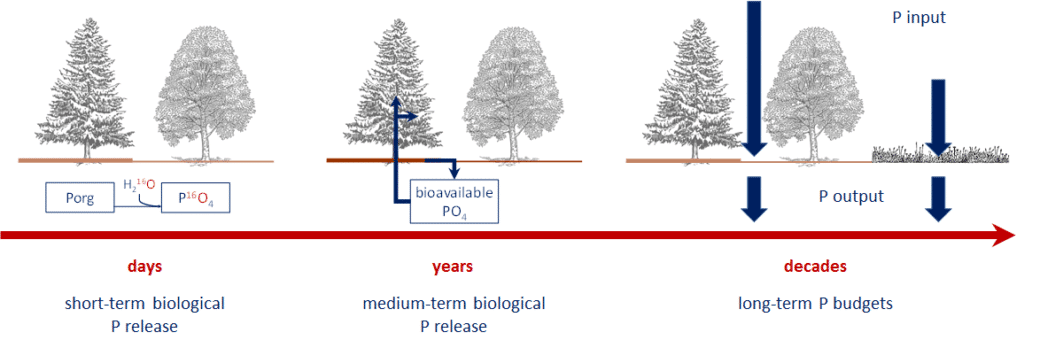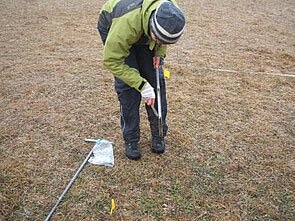Phosphorus content in forest soils of different biodiversity and land-use
Phosphorus (P) is an essential nutrient for photosynthetic carbon assimilation and, along with nitrogen (N), the element that can limit primary production. Due to N deposition and the associated change in N:P ratios in the biomass, the importance of P for plant growth and biodiversity is increasing. Despite the importance of P as a nutrient, the mechanisms of P release in soil are not completely understood. In forest soils, due to the high proportion of organic P (Po) stocks in the organic layer, the decomposition of organic material as a biologically controlled P release process plays a significant role in the P supply of organisms. Since the contents of plant-available inorganic P (Pi) in soils are mostly low, plants and soil organisms contribute to the release of Pi from organic material through exudation.
The results of previous investigations by DYNPHOS show that microbial biomass-P (Pmic) contents differ between regions and are related to P fractions in both forest and grassland soils. While land-use intensity has a large influence on the individual P fractions, Pmic seems to be independent of land-use intensity. The comparison between high and low plant diversity shows higher P utilisation with higher diversity of plant communities. Therefore, it can be said that especially in ecosystems with higher plant diversity, the competition for P between plants and microorganisms in the soil is important for the P supply of the plants. Furthermore, Pmic has been shown to correlate positively with Po in both forest and grassland soils. This proves the importance of organic matter as a substrate for microbial metabolism.
Land-use in forest and grassland soils must be adapted to the P cycle in such a way that P loss within the ecosystem is minimised, but at the same time the P supply to the plant remains guaranteed. Assessing the effectiveness of land-use requires
- knowledge of the main mechanisms (short-term) that contribute to P supply to the ecosystem,
- quantifying over what period of time (medium term) these mechanisms can guarantee P supply, and
- the long-term determination of the relationship between inputs and outputs of P in the ecosystem P cycle.
In the current project we therefore want to answer the following questions:
(1) How do land-use and biodiversity influence biological in-situ P release in forest soils in the short term?
(2) What effect do land-use and biodiversity have on P utilisation and medium-term biological P release in
forest soils?
(3) What conclusions for sustainable P management can be derived from the long-term budgets of ecosystem P
inputs and P outputs under different land-use and biodiversity?
We want to determine the short-term biological P release with the addition of glacier water, which has a different isotopic signature than the soil water in the exploratories. Enzyme-driven hydrolysis of phosphoric acid esters in soil organic matter is associated with the exchange of oxygen (O) atoms between phosphate and ambient water. The kinetics of the incorporation of glacial water (high proportion of 16O of O atoms in H2) into the released phosphate molecule could therefore be used to determine the current enzyme activity.
We will calculate P utilisation based on the annual uptake of P by plants relative to the potentially available P pool in the soil. In addition to P utilisation, the medium-term biological P release will be investigated.
The long-term P budget will be calculated as follows:
taking into account atmospheric deposition and fertilisation as inputs and harvesting, leaching and erosion of P as outputs. Previous calculations have shown that P budgets are negative in the regions studied. Therefore, the time period by which the plant-available P stocks in the soil are depleted is to be determined. An important, usually unnoticed, source of P in the forest is logging. For this purpose, we will process samples from the “Neighbor” project group from the previous phase and take new sample material in case of insufficient sample quantity. Furthermore, P discharge from both forest and grassland soils occurs particulate via erosion, which will also be quantified.
ALT F (2012): The Phosphorus Cycle in Grassland and Forest Ecosystems of different Biodiversity and Management. Diss. Eberhard Karls Universität Tübingen.
ALT F, OELMANN Y, HEROLD N, SCHRUMPF M, WILCKE W (2011): Phosphorus partitioning in grassland and forest soils of Germany as related to land-use type, management intensity, and land-use-related pH. J. Plant Nutr. Soil Sci., 174, 195-209.
ALT F, OELMANN Y, SCHÖNING I, WILCKE W (2013): Phosphate Release Kinetics in Calcareous Grassland and Forest Soils in Response to H+ Addition. Soil Sci. Soc. Am. J., 77, 2060-2070.
in cooperation with SCALEMIC: REGAN KM, NUNAN N, BOEDDINGHAUS RS, BAUMGARTNER V, BERNER D, BOCH S, OELMANN Y, OVERMANN J, PRATI D, SCHLOTER M, SCHMITT B, SORKAU E, STEFFENS M, KANDELER E, MARHAN S (2014): Seasonal controls on grassland microbial biogeography: Are they governed by plants, abiotic properties or both? Soil Biol. Biochem., 71, 21-30.
in cooperation with SOILAGG: BARTO KE, ALT F, OELMANN Y, WILCKE W, RILLIG MC (2010): Contributions of biotic and abiotic factors to soil aggregation across a land-use gradient. Soil Biol. Biochem., 42, 2316-2324.












